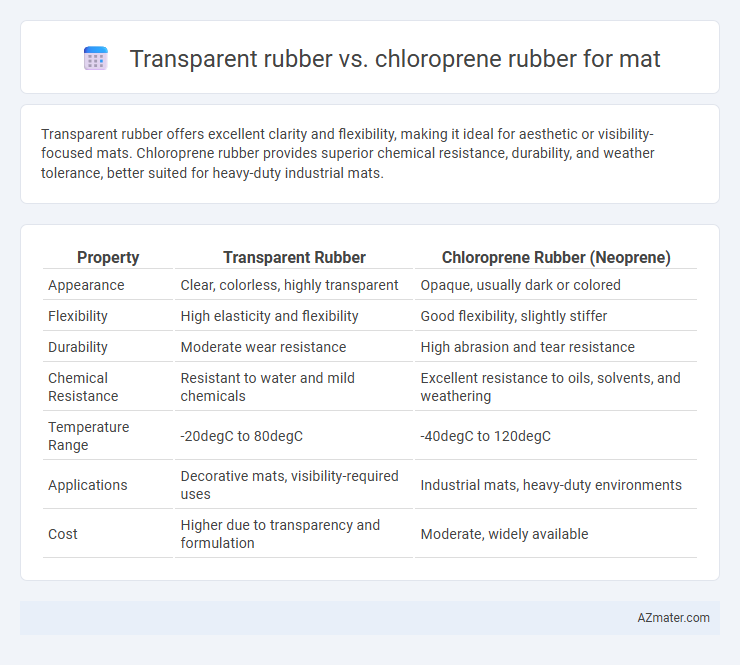Transparent rubber offers excellent clarity and flexibility, making it ideal for aesthetic or visibility-focused mats. Chloroprene rubber provides superior chemical resistance, durability, and weather tolerance, better suited for heavy-duty industrial mats.
Table of Comparison
| Property | Transparent Rubber | Chloroprene Rubber (Neoprene) |
|---|---|---|
| Appearance | Clear, colorless, highly transparent | Opaque, usually dark or colored |
| Flexibility | High elasticity and flexibility | Good flexibility, slightly stiffer |
| Durability | Moderate wear resistance | High abrasion and tear resistance |
| Chemical Resistance | Resistant to water and mild chemicals | Excellent resistance to oils, solvents, and weathering |
| Temperature Range | -20degC to 80degC | -40degC to 120degC |
| Applications | Decorative mats, visibility-required uses | Industrial mats, heavy-duty environments |
| Cost | Higher due to transparency and formulation | Moderate, widely available |
Introduction: Overview of Transparent Rubber and Chloroprene Rubber
Transparent rubber offers exceptional clarity, flexibility, and weather resistance, making it ideal for applications requiring visibility and durability in mats. Chloroprene rubber, also known as neoprene, provides superior chemical stability, oil resistance, and excellent mechanical properties, enhancing mat durability in harsh environments. Both materials balance flexibility and resilience, but transparent rubber prioritizes aesthetics, while chloroprene emphasizes performance under industrial conditions.
Material Composition and Structure
Transparent rubber typically consists of silicone or polyurethane with a clear molecular structure that allows light transmission, while chloroprene rubber (neoprene) is a synthetic polymer made from chloroprene monomers with a more opaque, cross-linked network. The material composition of transparent rubber offers higher optical clarity and flexibility, whereas chloroprene rubber provides enhanced chemical resistance and durability due to its heteroatom-rich polymer backbone. Structural differences impact mat applications, with transparent rubber favored for visibility and aesthetics, and chloroprene rubber chosen for robust performance in harsh environmental conditions.
Transparency and Aesthetic Appeal
Transparent rubber offers superior clarity and a glass-like appearance, making it ideal for mats where visibility and aesthetic appeal are prioritized. Chloroprene rubber, while durable and resistant to chemicals, typically has an opaque, matte finish that limits its use in applications requiring transparency. The choice between these materials depends largely on the need for visual appeal versus functional durability.
Durability and Wear Resistance
Transparent rubber mats exhibit moderate durability and wear resistance suitable for light to medium applications, with flexibility and clarity being primary advantages. Chloroprene rubber (Neoprene) mats outperform in durability and wear resistance, offering excellent resistance to abrasion, weathering, and chemicals, making them ideal for heavy-duty and industrial uses. The superior chemical stability and resilience of chloroprene rubber extend mat lifespan significantly compared to transparent rubber options.
Slip Resistance and Surface Grip
Transparent rubber mats offer superior slip resistance due to their high-friction surface texture, making them ideal for environments requiring enhanced surface grip. Chloroprene rubber, known for its excellent elasticity and chemical resistance, provides reliable slip resistance but may not match the transparency or precise grip characteristics of transparent rubber. Both materials deliver effective safety performance, but transparent rubber is preferred when visibility and maximized surface traction are critical.
Chemical and Weather Resistance
Transparent rubber offers excellent chemical resistance, effectively withstanding exposure to oils, acids, and solvents, making it suitable for mats used in harsh chemical environments. Chloroprene rubber (neoprene) demonstrates superior weather resistance, including resilience against ozone, UV rays, and temperature fluctuations, ensuring long-term durability outdoors. Both materials maintain flexibility under varying conditions, but chloroprene's balanced chemical and weather resistance skills make it ideal for applications requiring prolonged exposure to environmental stressors.
Comfort and Cushioning Properties
Transparent rubber offers superior flexibility and softness, enhancing comfort and cushioning in mats by providing a gentle, adaptive surface. Chloroprene rubber, known for its resilience and moderate elasticity, delivers durable cushioning but may feel firmer underfoot compared to transparent rubber. The choice between these materials depends on the desired balance between plush comfort and long-lasting support in mat applications.
Maintenance and Cleaning Requirements
Transparent rubber mats offer easier maintenance due to their non-porous surface, which resists stains and allows for quick cleaning with mild soap and water. Chloroprene rubber mats require more frequent cleaning and occasional use of specialized cleaners to prevent buildup of oils and dirt, preserving their flexibility and durability. Regular maintenance ensures Chloroprene's resistance to weathering and chemical exposure, while transparent rubber demands minimal effort to retain clarity and hygiene.
Environmental Impact and Sustainability
Transparent rubber mats, often made from silicone or clear polyurethane, offer better environmental sustainability due to their longer lifespan and higher recyclability compared to chloroprene rubber mats. Chloroprene rubber, derived from petrochemicals, produces more harmful emissions during manufacturing and is less biodegradable, contributing to environmental pollution. Choosing transparent rubber mats can reduce ecological footprints by minimizing toxic waste and supporting circular economy practices.
Applications: Choosing the Right Rubber for Your Mat
Transparent rubber offers excellent clarity and aesthetic appeal, making it ideal for decorative floor mats and display surfaces where visibility is crucial. Chloroprene rubber, known for its superior weather resistance, chemical stability, and durability, is preferred in industrial mats, anti-fatigue mats, and outdoor applications subject to harsh environmental conditions. Selecting the right rubber depends on whether the priority is visual transparency or resilience against abrasion, UV exposure, and chemicals.

Infographic: Transparent rubber vs Chloroprene rubber for Mat
 azmater.com
azmater.com